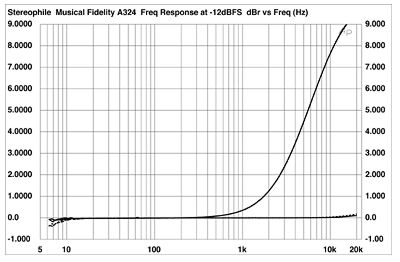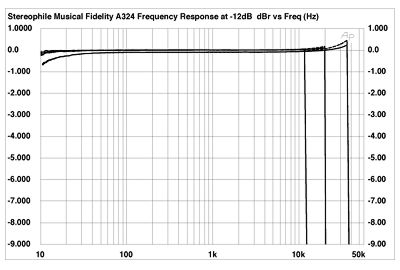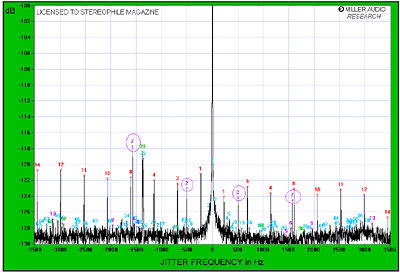| Columns Retired Columns & Blogs |
Musical Fidelity A324 D/A processor Measurements from July 2002
Sidebar: Measurements from July 2002 (Vol.25 No.7)
Footnote 1: Musical Fidelity Ltd., 15-17 Fulton Road, Wembley, Middlesex HA9 OTF, England, UK. Tel: (44) (0)181-900-2866. Web: www.musical-fidelity.co.uk. US distributor: Kevro International, Inc., 902 McKay Road, Pickering, Ontario, Canada L1W 3X8. Tel: (905) 428-2800. Fax: (905) 428-0004. Web: www.kevro.com.
Sam Tellig enthused about the Musical Fidelity A324 D/A processor (footnote 1) in his April 2002 column (Vol.25 No.4): "At $1195, it's an astonishing bargain that belongs in Class A of 'Recommended Components,' " he gushed, concluding that he "wouldn't drop money on a more costly digital processor without first hearing this one." I thought it worthwhile, therefore, to submit this upsampling processor—not "oversampling," as we termed it on our April cover, Musical Fidelity politely tells us—to Stereophile's usual measurement regime. (You can find what I felt about its sound quality in my review of the Chord DAC64 elsewhere in this issue.)
Looking first at the basics: The Musical Fidelity's single-ended outputs featured a source impedance of a very low 47 ohms across most of the audioband, this rising very slightly but insignificantly to 55 ohms at 20kHz. Unlike the earlier Musical Fidelity X-24K D/A processor, which I reviewed in February 1999, the A324 doesn't invert absolute polarity. The maximum output level at 1kHz was 2.173V RMS, 0.72dB above the 2V CD standard.
The DAC's frequency response for CD playback is shown as the lower pair of traces in fig.1; the very slight rise to +0.1dB at 20kHz will not be audible. However, the fact that the processor does not apply the appropriate de-emphasis for the small number of pre-emphasized CDs will be audible (fig.1, top traces). Fig.2 shows the A324's response when fed external data at 32kHz, 48kHz, and 96kHz sample rates, all of which it locked to without any bother. The very slight rise at the top of the audioband seen in fig.1 actually continues to rise at the higher sample rates, though this should not in itself have any audible consequences. Channel separation (not shown) was excellent at around 100dB in both directions; ie, buried beneath the unit's noise floor.

Fig.1 Musical Fidelity A324, frequency response at -12dBFS with 44.1kHz sampling, without emphasis (top) and with emphasis (bottom). (Right channel dashed, 0.5dB/vertical div.)

Fig.2 Musical Fidelity A324, frequency response at -12dBFS with (from left to right): 32kHz, 48kHz, and 96kHz sampling (right channel dashed, 1dB/vertical div.).
Fig.3 shows spectral analyses of that noise floor when the Musical Fidelity was driven with dithered 16- and 24-bit data representing a 1kHz tone at -90dBFS. The noise drops by around 17dB in the treble with the 24-bit data, suggesting that the A324 has a dynamic range in this range equivalent to almost 19 bits, which is excellent. The drop is lower at low frequencies, and the increase in bit depth unmasks a very slight amount of 60Hz power-supply noise, presumably due to magnetic coupling from the AC transformer. This can also be seen in a wider-band analysis of the DAC's noise floor while it decoded "digital black" (fig.4). At -126dB (0.00005%), however, the presence of this noise is of academic interest only, I would think. But it should be noted that I did find the Musical Fidelity to be somewhat sensitive regarding how it was grounded, if this 60Hz hum was not to rise in level.

Fig.3 Musical Fidelity A324, 1/3-octave spectrum of dithered 1kHz tone at -90dBFS, with noise and spuriae (from top to bottom): 16-bit data, 24-bit data (right channel dashed).

Fig.4 Musical Fidelity A324, 1/3-octave spectrum of "digital black," with noise and spuriae, 16-bit data (2dB/vertical div.).
Linearity error (fig.5) was the state of the art for 16-bit data. As a result of this and the low analog noise floor, the A324's reproduction of an undithered 1kHz sinewave at -90.31dBFS was essentially perfect (fig.6). Increasing the word length to 24 bits gave a good facsimile of a sinewave (fig.7).

Fig.5 Musical Fidelity A324, departure from linearity, 16-bit CD data (right channel dashed, 2dB/vertical div.).

Fig.6 Musical Fidelity A324, waveform of undithered 1kHz sinewave at -90.31dBFS, 16-bit data.

Fig.7 Musical Fidelity A324, waveform of undithered 1kHz sinewave at -90.31dBFS, 24-bit data.
Try as I might, I could find no harmonic distortion products in the Musical Fidelity's output (fig.8), and, other than a trace of 1kHz difference product (fig.9), intermodulation distortion was similarly missing in action.

Fig.8 Musical Fidelity A324, spectrum of 50Hz sinewave, DC-1kHz, at 0dBFS into 600 ohms (linear frequency scale).

Fig.9 Musical Fidelity A324, HF intermodulation spectrum, DC-24kHz, 19+20kHz at 0dBFS into 100k ohms (linear frequency scale).
Finally, I used the Miller Audio Research jitter analyzer to look at the effect of word-clock jitter on the A324's analog output. The source was my usual PS Audio Lambda transport, driving the processor via 6' of S/PDIF cable. The measured jitter level was superbly low at 147.7 picoseconds peak-peak, and a narrow-band spectral analysis of the noise floor (fig.10) indicated that the jitter components present were predominantly data-related (red numeric markers). While pairs of sidebands were present at ±505Hz (purple "2") and ±1.57kHz (purple "7"), these are very low in level in absolute terms. When I drove the A324 from the RME soundcard in my PC using a TosLink datalink, the jitter level rose slightly, to a still low 169.7ps, which suggests that it has an excellent data-recovery circuit. This was with the upsampling set to 192kHz. Reducing it to 96kHz made no difference. In fact, I could find no measurable changes associated with the two different upsampling rates.

Fig.10 Musical Fidelity A324, high-resolution jitter spectrum of analog output signal, PS Audio Lambda 2 transport via 6' Apature S/PDIF link (11.025kHz at -6dBFS with LSB toggled at 229Hz). Center frequency of trace, 11.025kHz; frequency range, ±3.5kHz.
This is superb measured performance, with no indication that Musical Fidelity's A324 has been compromised in any way to get its price down to below $1200.—John Atkinson
Footnote 1: Musical Fidelity Ltd., 15-17 Fulton Road, Wembley, Middlesex HA9 OTF, England, UK. Tel: (44) (0)181-900-2866. Web: www.musical-fidelity.co.uk. US distributor: Kevro International, Inc., 902 McKay Road, Pickering, Ontario, Canada L1W 3X8. Tel: (905) 428-2800. Fax: (905) 428-0004. Web: www.kevro.com.
- Log in or register to post comments




































